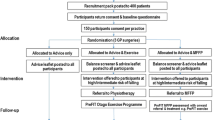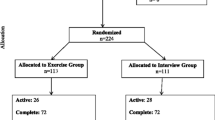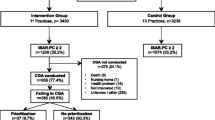Abstract
Current approaches to falls prevention mostly rely on secondary and tertiary prevention and target individuals at high risk of falls. An alternative is primary prevention, in which all seniors are screened, referred as appropriate, and educated regarding falls risk. Little information is available on research designs that allow investigation of this approach in the setting of aging services delivery, where randomization may not be possible. Healthy Steps for Older Adults, a statewide program of the Pennsylvania (PA) Department of Aging, involves a combination of education about falls and screening for balance problems, with referral to personal physicians and home safety assessments. We developed a non-randomized statewide trial, Falls Free PA, to assess its effectiveness in reducing falls incidence over 12 months. We recruited 814 seniors who completed the program (503 first-time participants, 311 people repeating the program) and 1,020 who did not participate in the program, from the same sites. We assessed the quality of this non-randomized design by examining recruitment, follow-up across study groups, and comparability at baseline. Of older adults approached in senior centers, 90.5 % (n = 2,219) signed informed consent, and 1,834 (82.4 %) completed baseline assessments and were eligible for follow-up. Attrition in the three groups over 12 months was low and non-differential (<10 % for withdrawal and <2 % for other loss to follow-up). Median follow-up, which involved standardized monthly assessment of falls, was 10 months in all study groups. At baseline, the groups did not differ in measures of health or falls risk factors. Comparable status at baseline, recruitment from common sites, and similar experience with retention suggest that the non-randomized design will be effective for assessment of this approach to primary prevention of falls.

Similar content being viewed by others
References
American Geriatrics Society, British Geriatrics Society. (2010). 2010 AGS/BGS clinical practice guideline: Prevention of falls in older persons. Retrieved from http://www.medcats.com/FALLS/frameset.htm.
Batchelor, F. A., Mackintosh, S. F., Said, C. M., & Hill, K. D. (2012). Falls after stroke. International Journal of Stroke, 7, 482–490. doi:10.1111/j.1747-4949.2012.00796.x.
Buschke, H., Kuslansky, G., Katz, M., Stewart, W. F., Sliwinski, M. J., Eckholdt, H. M., et al. (1999). Screening for dementia with the memory impairment screen. Neurology, 52, 231–238.
Chase, C. A., Mann, K., Wasek, S., & Arbesman, M. (2012). Systematic review of the effect of home modification and fall prevention programs on falls and the performance of community-dwelling older adults. The American Journal of Occupational Therapy, 66, 284–291. doi:10.5014/ajot.2012.005017.
Gangavati, A., Hajjar, I., Quach, L., Jones, R. N., Kiely, D. K., Gagnon, P., et al. (2011). Hypertension, orthostatic hypotension, and the risk of falls in a community-dwelling elderly population: The maintenance of balance, independent living, intellect, and zest in the elderly of Boston study. Journal of the American Geriatrics Society, 59, 383–389. doi:10.1111/j.1532-5415.2011.03317.x.
Gates, S., Fisher, J. D., Cooke, M. W., Carter, Y. H., & Lamb, S. E. (2008). Multifactorial assessment and targeted intervention for preventing falls and injuries among older people in community and emergency care settings: Systematic review and meta-analysis. British Medical Journal, 336, 130–133. doi:10.1136/bmj.39412.525243.BE.
Gillespie, L. D., Robertson, M. C., Gillespie, W. J., Sherrington, C., Gates, S., Clemson, L. M., et al. (2012). Interventions for preventing falls in older people living in the community. The Cochrane Database of Systematic Reviews, 9, CD007146. doi:10.1002/14651858.CD007146.pub3.
Grabiner, M. D., Donovan, S., Bareither, M. L., Marone, J. R., Hamstra-Wright, K., Gatts, S., et al. (2008). Trunk kinematics and fall risk of older adults: Translating biomechanical results to the clinic. Journal of Electromyography and Kinesiology, 18, 197–204. doi:10.1016/j.jelekin.2007.06.009.
Hammer, J. (2010). Increasing number of unintentional falls indicates urgent need for fall prevention programs. Journal of the American Geriatrics Society, 58, 603–604.
Hausdorff, J. M., Rios, D. A., & Edelberg, H. K. (2001). Gait variability and fall risk in community-living older adults: A 1-year prospective study. Archives of Physical Medicine and Rehabilitation, 82, 1050–1056. doi:10.1053/apmr.2001.24893.
Health Research for Action, University of California Berkeley. (2013). PA healthy steps for older adults. Retrieved from http://www.healthresearchforaction.org/pennsylvanias-healthy-steps-older-adults.
Hill, A. M., Hoffmann, T., McPhail, S., Beer, C., Hill, K. D., Oliver, D., et al. (2011). Evaluation of the sustained effect of inpatient falls prevention education and predictors of falls after hospital discharge—Follow-up to a randomized controlled trial. The Journals of Gerontology A Biological Sciences Medical Sciences, 66, 1001–1012. doi:10.1093/gerona/glr085.
Hiorth, Y. H., Lode, K., & Larsen, J. P. (2013). Frequencies of falls and associated features at different stages of Parkinson’s disease. European Journal of Neurology, 20, 160–166. doi:10.1111/j.1468-1331.2012.03821.x.
Kind, P., Dolan, P., Gudex, C., & Williams, A. (1998). Variations in population health status: Results from a United Kingdom national questionnaire survey. British Medical Journal, 316, 736–741.
Levinger, P., Menz, H. B., Wee, E., Feller, J. A., Bartlett, J. R., & Bergman, N. R. (2011). Physiological risk factors for falls in people with knee osteoarthritis before and early after knee replacement surgery. Arthroscopy, 19, 1082–1089. doi:10.1007/s00167-010-1325-8.
Lipton, R. B., Katz, M. J., Kuslansky, G., Sliwinski, M. J., Stewart, W. F., Verghese, J., et al. (2003). Screening for dementia by telephone using the memory impairment screen. Journal of the American Geriatrics Society, 51, 1382–1390.
Logan, P. A., Coupland, C. A., Gladman, J. R., Sahota, O., Stoner-Hobbs, V., Robertson, K., et al. (2010). Community falls prevention for people who call an emergency ambulance after a fall: Randomised controlled trial. British Medical Journal, 340, c2102. doi:10.1136/British Medical Journal.c2102.
Lopez, D., McCaul, K. A., Hankey, G. J., Norman, P. E., Almeida, O. P., Dobson, A. J., et al. (2011). Falls, injuries from falls, health related quality of life and mortality in older adults with vision and hearing impairment—Is there a gender difference? Maturitas, 69, 359–364. doi:10.1016/j.maturitas.2011.05.006.
Morley, J. E. (2002). A fall is a major event in the life of an older person. The Journals of Gerontology A Biological Sciences Medical Sciences, 57, M492–M495.
Moyer, V. A., & US Preventive Task Force. (2012). Prevention of falls in community-dwelling older adults: U.S. Preventive Services Task Force recommendation statement. Annals of Internal Medicine, 157, 197–204. doi:10.7326/0003-4819-157-3-201208070-00462.
National Center for Injury Prevention and Control. (2012). Web-based Injury Statistics Query and Reporting System (WISQARS). Retrieved from www.cdc.gov/injury/wisqars/index.html.
Pennsylvania Department of Aging. (2013). Pennsylvania’s healthy steps for older adults. Retrieved from http://www.portal.state.pa.us/portal/server.pt/community/health_and_nutrition/17886/primetime_health/616002.
Pit, S. W., Byles, J. E., Henry, D. A., Holt, L., Hansen, V., & Bowman, D. A. (2007). A quality use of medicines program for general practitioners and older people: A cluster randomised controlled trial. The Medical Journal of Australia, 187, 23–30.
Salkeld, G., Cumming, R. G., & Thomas, M. (2008). The cost effectiveness of a home hazard reduction program to reduce falls among older persons. Australian and New Zealand Journal of Public Health, 24, 265–271.
Salminen, M. J., Vahlberg, T. J., Salonoja, M. T., Aarnio, P. T., & Kivela, S. L. (2009). Effect of a risk-based multifactorial fall prevention program on the incidence of falls. Journal of the American Geriatrics Society, 57, 612–619. doi:10.1111/j.1532-5415.2009.02176.x.
Shaw, J. W., Johnson, J. A., & Coons, S. J. (2005). US valuation of the EQ-5D health states: Development and testing of the D1 valuation model. Medical Care, 43, 203–220.
Sherrington, C., Tiedemann, A., Fairhall, N., Close, J. C., & Lord, S. R. (2011). Exercise to prevent falls in older adults: An updated meta-analysis and best practice recommendations. New South Wales Public Health Bulletin, 22, 78–83. doi:10.1071/NB10056.
Skelton, D., Dinan, S., Campbell, M., & Rutherford, O. (2005). Tailored group exercise (Falls Management Exercise—FaME) reduces falls in community-dwelling older frequent fallers (an RCT). Age and Ageing, 34, 636–639. doi:10.1093/ageing/afi174.
Stevens, J. A., & Phelan, E. A. (2013). Development of STEADI: A fall prevention resource for health care providers. Health Promotion Practice, 14, 706–714. doi:10.1177/1524839912463576.
Stevens, J. A., & Sogolow, E. D. (2005). Gender differences for non-fatal unintentional fall related injuries among older adults. Injury Prevention: Journal of the International Society for Child and Adolescent Injury Prevention, 11, 115–119. doi:10.1136/ip.2004.005835.
Stewart, A. L., Mills, K. M., King, A. C., Haskell, W. L., Gillis, D., & Ritter, P. L. (2001). CHAMPS physical activity questionnaire for older adults: Outcomes for interventions. Medicine and Science in Sports and Exercise, 33, 1126–1141.
Tinetti, M. E., & Kumar, C. (2010). The patient who falls: “It’s always a trade-off. The Journal of the American Medical Association, 303, 258–266. doi:10.1001/jama.2009.2024.
Tinetti, M. E., Richman, D., & Powell, L. (1990). Falls efficacy as a measure of fear of falling. Journal of Gerontology, 45, 239–243.
Tinetti, M. E., Baker, D. I., King, M., Gottschalk, M., Murphy, T. E., Acampora, D., et al. (2008). Effect of dissemination of evidence in reducing injuries from falls. New England Journal of Medicine, 359, 252–261. doi:10.1056/NEJMoa0801748.
Whitney, J., Close, J. C., Jackson, S. H., & Lord, S. R. (2012). Understanding risk of falls in people with cognitive impairment living in residential care. Journal of the American Medical Directors Association, 13, 535–540. doi:10.1016/j.jamda.2012.03.009.
Wijlhuizen, G. J., Hopman-Rock, M., Knook, D. L., & van der Cammen, T. J. (2006). Automatic registration of falls and other accidents among community dwelling older people: Feasibility and reliability of the telephone inquiry system. International Journal of Injury Control and Safety Promotion, 13, 58–60. doi:10.1080/15660970500036937.
Woolcott, J. C. (2009). Meta-analysis of the impact of 9 medication classes on falls in elderly persons. Archives of Internal Medicine, 169, 1952–1960.
Acknowledgments
This research was supported by Cooperative Agreement DP002657 from the Centers for Disease Control and Prevention, CDC Prevention Research Centers program U48 DP001918, and NIH P30 AG024827. Findings and conclusions are those of the author and do not necessarily represent the official position of the Centers for Disease Control and Prevention.
Author information
Authors and Affiliations
Corresponding author
Rights and permissions
About this article
Cite this article
Albert, S.M., Edelstein, O., King, J. et al. Assessing the Quality of a Non-randomized Pragmatic Trial for Primary Prevention of Falls among Older Adults. Prev Sci 16, 31–40 (2015). https://doi.org/10.1007/s11121-014-0466-2
Published:
Issue Date:
DOI: https://doi.org/10.1007/s11121-014-0466-2




